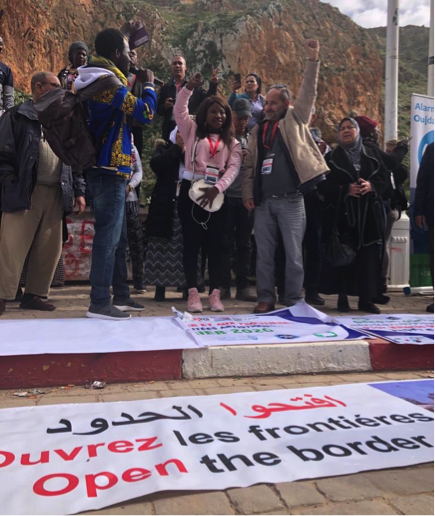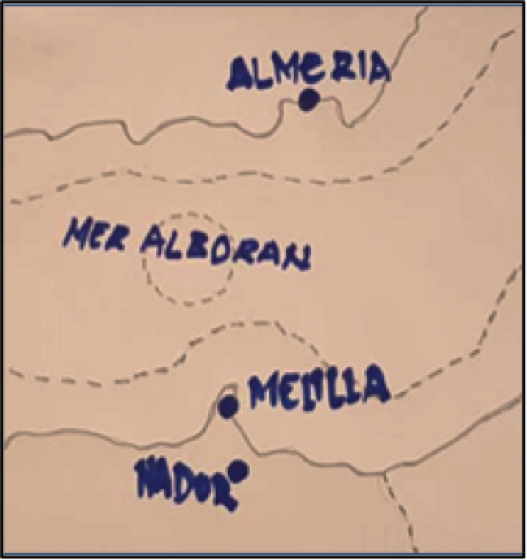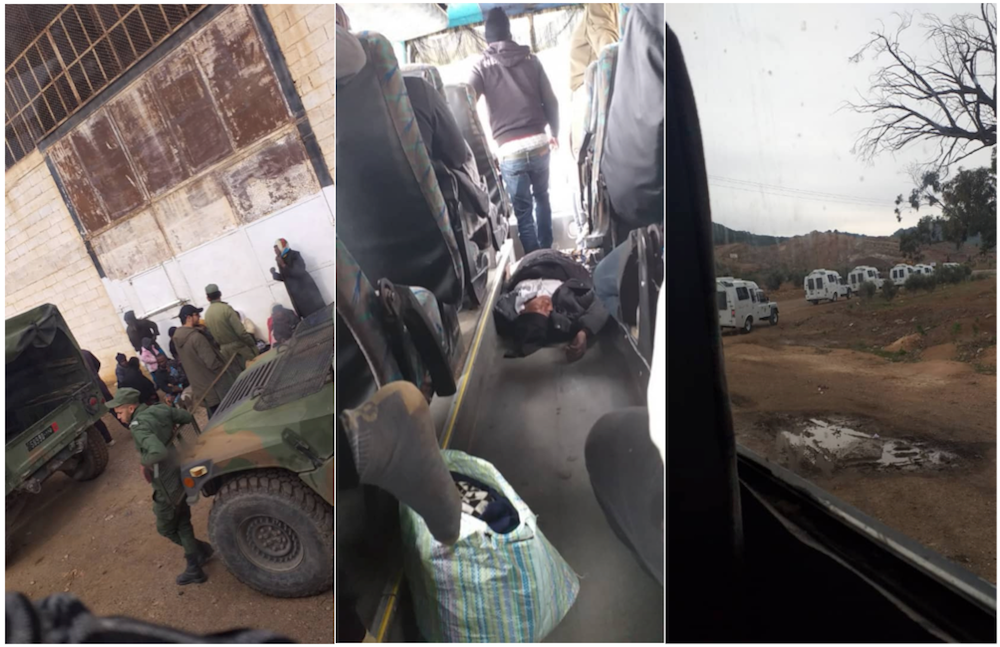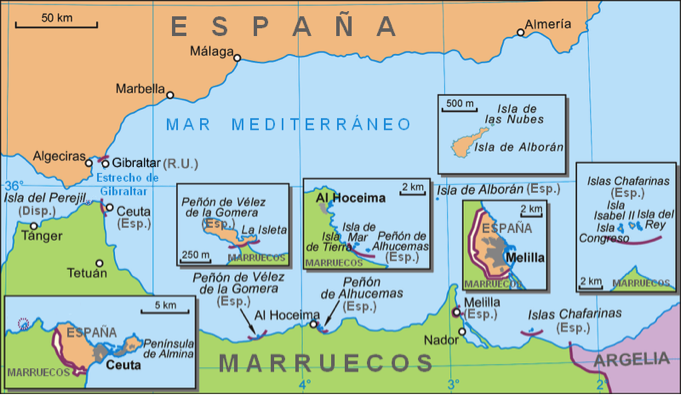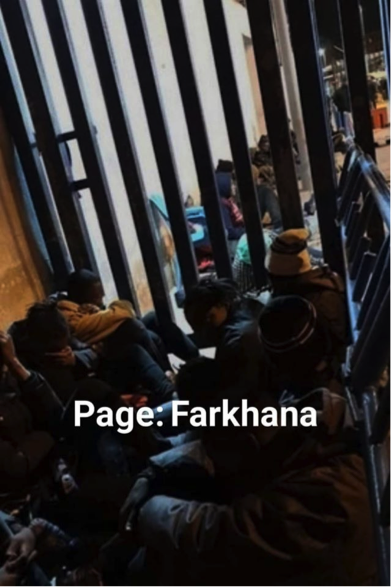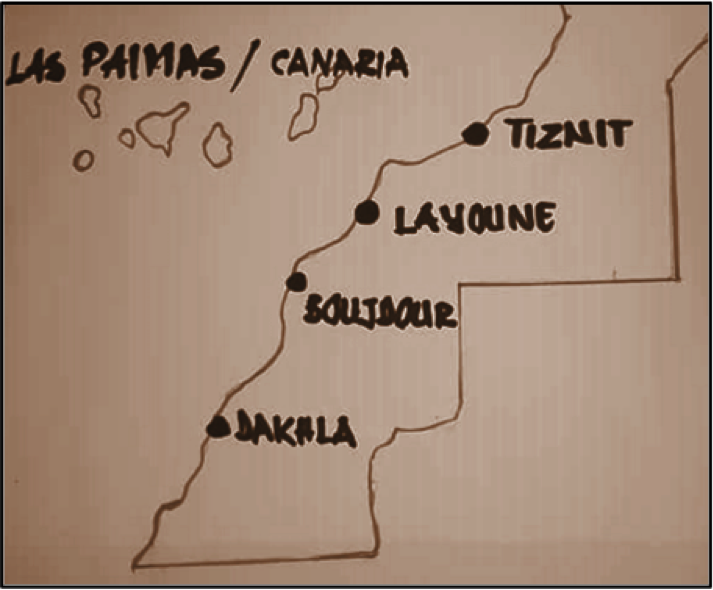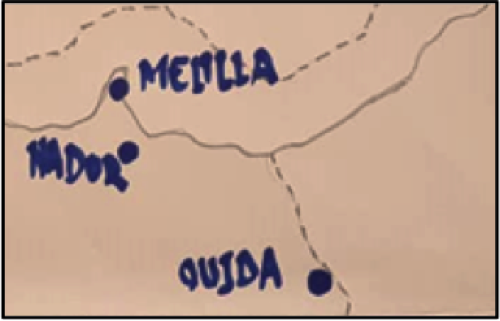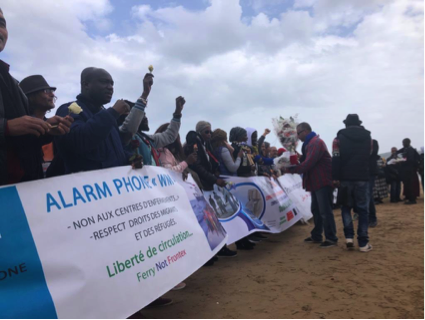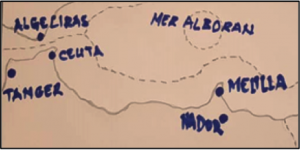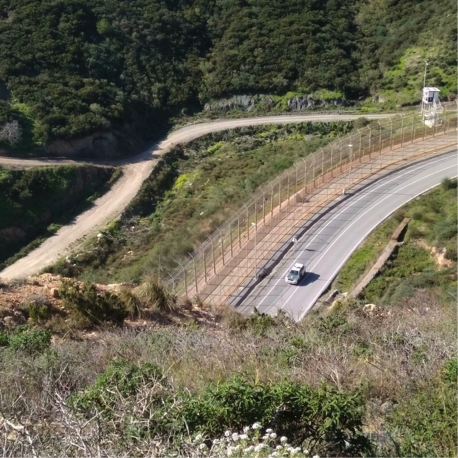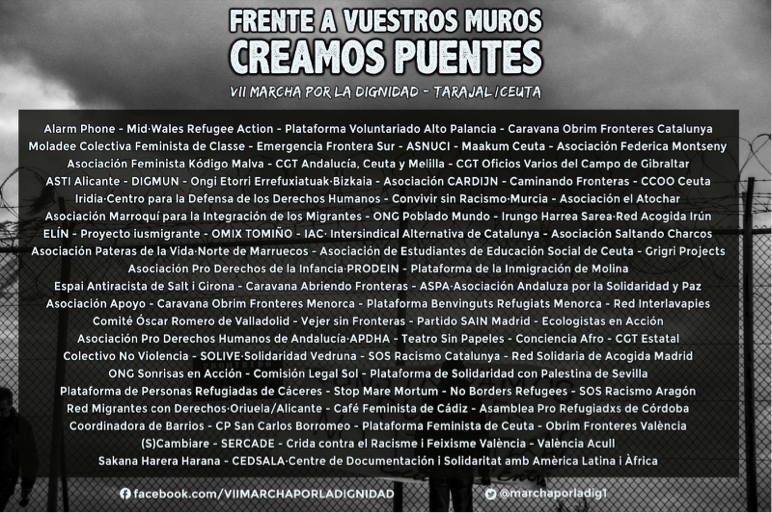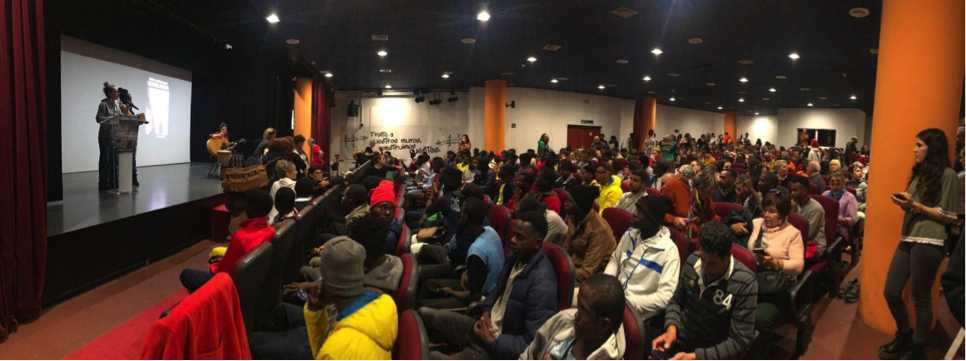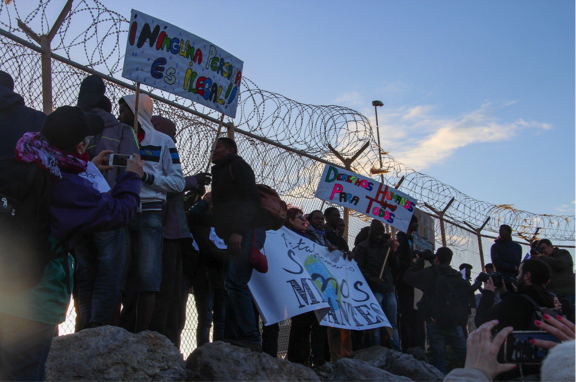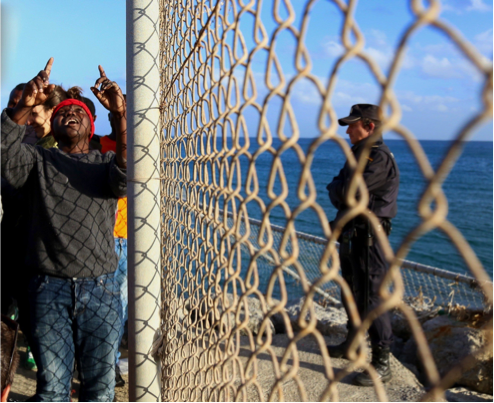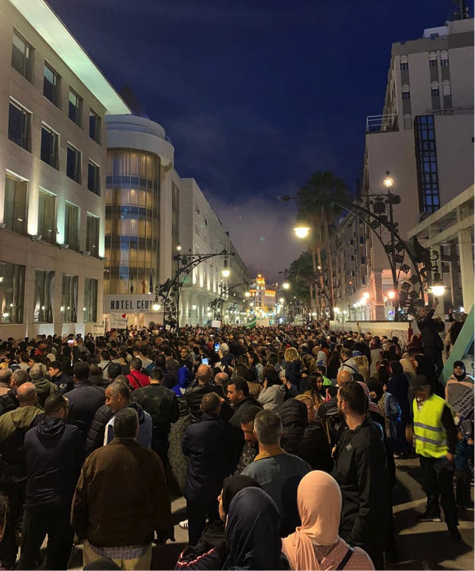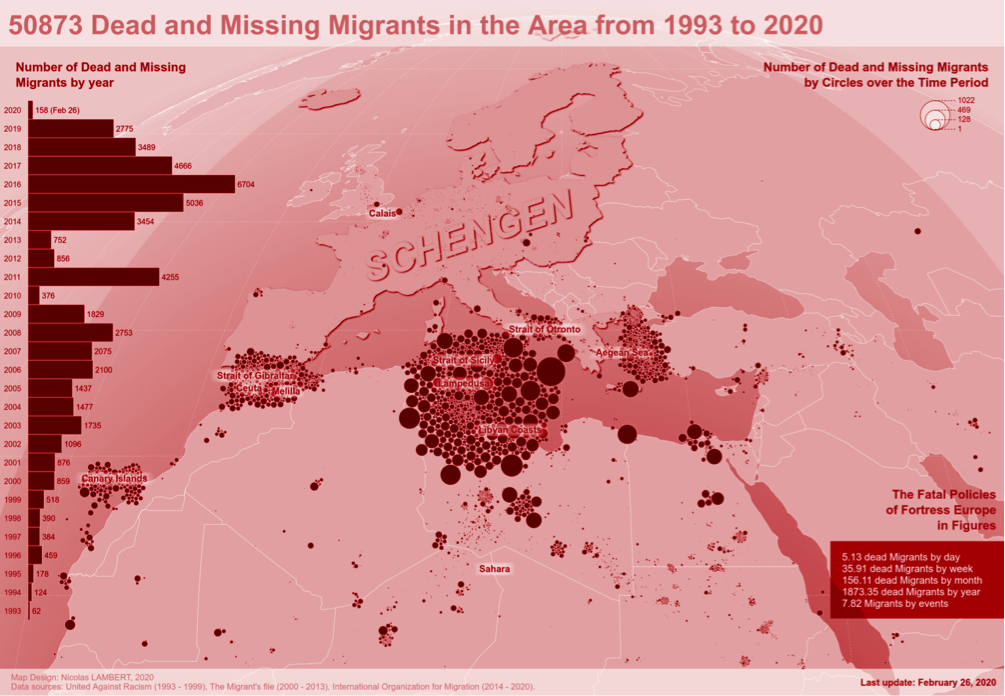Turbulent Times: Political Repression and Response(s) in the Western Med
These are turbulent times in the struggle for freedom of movement on the Western Mediterranean Front. Long standing routes for crossings into EUrope seem to have been closed off, whilst the tried and tested locations for the organization of crossings, such as the city of Tangier and the forests around Nador, are regularly raided and are now nearly empty of Sub-Saharan travellers. On the other hand, new routes are being developed and established. These new routes take people to the Spanish islets north of the Moroccan coast or towards the Canary islands. Local contacts testify to the development of migration hotspots in Dakhla, far south in Western Sahara, and boats are even starting from Senegal and the Gambia to travel to the Spanish islands. This is a whole new challenge for the Alarm Phone shift teams as there is no network coverage throughout the whole crossing and the travellers do not (yet?) use satellite telephones on these routes. As a consequence, we often lose connection with the boats calling us from these areas.
In the meantime, repression is as fierce as ever in the northern border zones. The NGO ‘Pateras de la vida’ estimate that some 10,000 Sub-Saharan nationals were arrested in Morocco and pushed south or east in 2019 and another 3000 people were deported to their countries of origin, most of them to Guinea Conakry, Mali and Cameroon.[1]
Politically there have been setbacks and successes. For example an ECtHR ruling legitimized a push-back at the Melilla border fence, but we managed, despite the opposition of the local authorities, to hold a large protest at the Algerian border which commemorated dead and missing travellers. Moreover, at the end of February, we witnessed the unprecedented number of 8000 people marching in Ceuta against institutionalized racism. It is far from quiet on the western front!
In the following Western Med Regional Analysis we try to document developments and dynamics affecting the of possibility of transit via Morocco to the European Union. We try to do so from the ground up. We also try to bear in mind that Morocco is a place of departure for a significant number of Moroccans leaving on boats for Europe, the so called “harragas”.
At the end of December, the Moroccan High Commissioner for Planning (Haut Commissariat au Plan, HCP) released data on migration dynamics out of Morocco from a study conducted between August 2018 and January 2019. According to the survey, nearly a quarter (23.3%) of the interviewed Moroccan nationals expressed their intention to emigrate.[2][3] We are aware that in our Western Med Analysis Moroccan harragas are not sufficiently represented. It is more complicated to create networks which include Moroccan travellers due to political obstacles and the fear of criminalization.
For a deeper reflection on the AP Western Med Regional Analysis in general, see the preface of our last report “The hidden battlefield – struggles for freedom of movement in Morocco”.
The content of the following report:
1 Sea Crossings and AP Experiences
2 News from the Regions
2.1 Tangier and the Strait of Gibraltar
2.2 Nador and the Forests
2.3 The Western Saharan Route
2.4 Oujda
2.5 The Enclaves: Ceuta and Melilla
2.6 Algeria
3 Political Dynamics in the Western Med
4 Shipwrecks and Missing People
1 Sea crossings and AP experiences
As of 23rd of February, 4,235 people have managed to reach Spain in 2020. 3,313 of those people crossed via sea borders.[4] 1,029 of them crossed to the Canary islands[5] – 15 times more than in the same period in the previous year.[6] This is the only route to see a rise in the number of crossings – overall sea crossings have declined by 32% in comparison to the same period of 2019.[7]
The Alarm Phone handled 39 cases in the Western Mediterranean during the period covered by this report, November 2019-February 2020. A good half of these cases, 20, resulted in safe rescue to Spanish coasts, while 13 were intercepted or rescued to Morocco, two of them after capsizing. One boat returned back to Morocco under its own steam. 5 boats went missing without trace.
Most of the calls we received came from the Western Saharan route. Our collaboration with the Spanish Rescue organization Salvamento Marítimo was largely one of cooperation. As it is impossible to keep phone contact with boats on this route due to the lack of network coverage, the search and rescue operations take much longer. It is very hard to locate the boats. Sometimes it took days before the boats were found by SM. On the other routes, across the Strait of Gibraltar or the Alborán Sea, it became more difficult to organize rescue by Salvamento. On many occasions the responding officers in Tarifa or Algeciras simply referred the case to the Moroccan Marine Royale as the responsible rescue authority.
Exemplary Alarm Phone cases:
- On Sunday, 1st of December, at 23:09 CET, the Alarm Phone was alerted by a relative to a boat carrying 31 people, including five women and a child, which had departed from Dakhla the previous night at 22:00. For 23 hours the relative had not been able to reach the travellers. Our shift team also failed to establish communication with the travellers, despite trying continuously for several days whilst the case was ongoing. At 23:40 we called Salvamento Marítimo (SM) in Las Palmas and passed on the information that we had. However, as it was night, search and rescue was difficult. The following morning we spoke to SM again, and they confirmed that they would send an aircraft to the area to search for the boat. At 12:26 we called SM again. They confirmed that their aircraft was still searching, but had no news. We stayed in contact with SM who carried out a second search operation with their aircraft the same afternoon, before pausing their efforts for the night. On 3rd of December we were again in contact throughout the whole day with SM who searched the area by plane and with a boat. We were able to monitor the trajectory of their search and rescue vessel and aircraft online, but the day ended without any news about the whereabouts of the travellers. On 4th of December rescue efforts continued, and at 13:35 SM informed us that they were carrying out a rescue of 25-30 travellers. Later on in the evening the relative told us that the travellers had been rescued and brought to Las Palmas. After so many days at sea finally… Boza! Welcome to Europe!
- On 16th of December, in the very early morning, our shift team was contacted by relatives about a boat that had left from around Nador and which was about to lose air. The telephone number we were provided with was unreachable throughout the night. Contact to the relative also broke down. At 07:15 the travellers called the Alarm Phone by themselves and stated that the situation was bad and that they could still see the Moroccan coast line. When our shift team called MRCC Rabat at 07:50, they learned that the Moroccan authorities had been informed by MRCC Madrid and that the Moroccan Navy was already searching for the travellers. 40 minutes later MRCC Rabat informed us to that they had located the boat between Nador and Al Hoceima. Around 09:00 we provided all authorities with the information by email. When we called MRCC Rabat 15 minutes later they confirmed the ongoing rescue. The Alarm Phone couldn’t re-establish contact with the travellers. Around 15:00 the NGO Caminando Fronteras tweeted about a tragedy: “At least twenty-two survivors hospitalized and only seven corpses recovered.” The AP shift team called MRCC Rabat at 14:50 and was informed that 63 people had been rescued, 7 people had died and some people were still missing. Through various phone calls with the authorities in Morocco our shift teams learned that the search for the missing people was ongoing overnight. The next day we learned from the NGO AMDH (Moroccan Human Rights Association) that in total 84 people had been rescued. 8 people had been brought to the hospital in Nador. 7 people lost their lives.[8][9] Our condolences go to the families and friends of the deceased. Our anger burns about yet another avoidable tragedy.
- On 7th of January the Alarm Phone shift team was contacted at 03:01 by twelve people on a dinghy off Tangier. They needed urgent help and we informed the Moroccan authorities directly. During the rescue, at around 06:30, everyone fell into the sea. Shortly afterwards, eleven people were brought to safety on board the rescue vessel, although one person, Bakari Demba from Senegal, remained missing. The AP shift team was in direct contact with one rescued person, who reported right after the rescue operation, that their friend, Bakari Demba, disappeared and was not found by the Moroccan authorities. We called on the Moroccan Navy & the Spanish Salvamento to search for him. As we learned that he was a good swimmer, even hours later everybody was hoping for the best. At 16:15 MRCC Rabat said they were still searching for the missing person. We were not able to confirm this and instead urgently asked the Moroccan Navy & the Spanish to do what they could to find this person. Bakari Demba from Senegal was never found. Our thoughts are with his family and friends. We will not forget him and continue our fight against Borders and European Border policies.
2 News From the Regions
As mentioned in the introduction, there is no respite for Sub-Saharan people in Morocco, whether in transit, in possession of residency papers or undocumented.
In the beginning of November, a few days after an announcement by bus companies that they would systematically check the papers of people suspected of being black prior to boarding went viral (see our last WM Analysis[10]), the Moroccan government called the practice of racial profiling “discriminatory”. “If any of the Moroccan or foreign carriers resort to racist practices, we denounce it totally”, spokesperson Hassan Abyaba, announced.
This statement of the spokesperson of the Moroccan government is beyond hypocritical. Racial profiling is an everyday practice of the Gendarmerie Royale. They like to “collect blacks” with or without legal papers in order to push them to the country’s southern or eastern border zones or to their supposed countries of origin. This statement shows once again the discrepancy between official public discourse and everyday practice by officials in Morocco.
Even worse hypocrisy was in evidence with the arrest of a bus driver and his assistant 10 km outside of Casablanca on 9th of February this year. The police had ‘detected’ four Sub-Saharan travellers without valid residency papers (cartes de séjour) in the bus, the travellers were arrested and the driver and his assistant accused of trafficking. They spent two days in prison and were brought to court two days later. The workers’ union, UMT, made a lot of pressure in solidarity with their colleagues. The judge decided in favour of the accused. They were acquitted of all charges.[11]
2.1 Tangier and the Strait of Gibraltar
Tangier, gateway to the ocean, with its opening on the Strait of Gibraltar, remains a strategic place for travellers in transit, but is a city that is increasingly difficult to live in. Sub-Saharan people are subject to increased repression and police violence, refoulement or deportation to their countries of origin. In the last two years, the Moroccan State, which has acquired significant financial and logistical resources through Spain and the EUropean Union to curb the mobility of people moving north, has placed particular emphasis on Tangier. There is a massive police presence which is in turn supported by a military force responsible for maintaining law and order in the kingdom and who fall under the jurisdiction of the Ministry of the Interior.
These authorities create a climate of fear that makes life in the city hard to bear for Sub-Saharan people with or without papers. In the neighbourhoods of Mesnana, Branes, Boukhalef and Hawmat Chouk black people are arrested in cafes, restaurants, and even in their homes. Every day arrests take place, people are taken to police stations, registered, and then deported handcuffed and in undignified conditions to other cities. One popular destination is Tiznit, 900 km to the south. Some are deported to their countries of origin. In the middle of the day, Sub-Saharans are beaten up (activists on the ground speak of skull fractures, injuries to feet, arms, etc.[12]).
In the last two months, the pressure has dropped and forced removals have slightly decreased. This is probably a result of the ‘success’ of the repression in diminishing the importance of the city to travellers. People are reportedly forced to move away to cities such as Casablanca, Rabat or Agadir, thus escaping violence and police controls whilst preparing for the journey. In addition, there are vast operations aimed at dismantling smuggling networks and arresting smugglers. This makes the organization of departures more and more difficult. For example, at the beginning of January, in the Tangiers region, the Moroccan police announced the dismantling of “a criminal network involved in the organisation of illegal emigration operations”.[13]
The climate remains very tense in Tangier. Activists on the spot report cases of theft of personal belongings by the police from inside the collective houses in which Sub-Saharans live while waiting for departure. A small community remains in the neighbourhoods of Boukhalef and Mesnana, forced to hide and live in difficult conditions while waiting to travel. Forced removals to the South have not stopped. As before, there are cases of people expelled who have shown valid residence papers.
Local contacts reported that, on 28th of January, police forced the entrance of a house inhabited by Cameroonians and arrested more than 8 people who were immediately taken to Tiznit. The only way for people not to be returned to Tiznit, Dakhla or Laâyoune is to pay a sum to the Moroccan police (100 or 200 DH). It needs to be deposited in Rabat or Kénitra (north of Rabat)[14].
2.2 Nador and the forests
Repression is also at fever pitch in Nador and its forested environs. In mid November, increased numbers of raids were conducted by Moroccan paramilitary forces in Nador and the surrounding forests where about 15-20 different makeshift camps were still scattered about despite the eviction of the Gurugu mountain in 2015.[15]
During the violent destructions of these makeshift camps of the Sub-Saharans who wait in the forests for their chance to cross to Spain many people are injured. In particular, reports about violence towards women reach us – it is unfortunately safe to say – regularly. According to the AMDH, around 2,000 travellers have been treated in the hospital of Nador during 2019 alone[16], ironically many of them after being beaten up by the state forces themselves.
Police raids mid-November around Nador. Source: AMDH Nador
The people arrested are, by and large, brought to the detention facility of Arekmane, formly a summer camp centre of the Ministry of Youth and Sport. This facility is highly contested. As part of its monitoring of violations committed against Sub-Saharan travellers in Nador, the AMDH visited the Arekmane detention center on Friday, 27th of December. They were able to observe the activities of the Gendarmerie Royale on the spot. Dozens of travellers are detained here outside of any legal proceedings. Article 34 of Law 02 – 03, which relates to the Entry and Stay of Foreigners, stipulates preconditions for detention that are never respected. According to the law, a written detention decision by the administration must be issued and the detainees are to be informed about their rights with an interpreter.[17] This is a joke.
The AMDH issued a communiqué to the commander of the Gendarmerie Royale in Nador demanding the immediate closure of the facility.[18] We are in awe of the energy and actions of our comrades in the AMDH and echo their demand to end the detention of travellers immediately!
But activities in Arekmane do not suggest that a closure will happen any time soon. The AMDH closely follow the movements to and from the center. They report that towards the end of December, in one week alone, nearly 350 travellers were refouled from Arekmane after about 20 days of illegal detention. They also report that every night two busses leave from there, one brings travellers to remote areas, such as the Algerian border or the south of Morocco, and one leaves for Casablanca airport to facilitate deportations and refoulments to people’s countries of origin.[19]
During the week of the 22nd of November, several raids took place in the forests of Nador and the arrested were transported to the border with Algeria at Jerada or Oujda. The people were moved to desert zones at night where it is cold with a high risk of snow.[20]
The deportations to the Algerian border are dangerous and also complicated by the tense relations between Morocco and Algeria. Our contacts followed up a group of 14 people who were removed from the Arekmane detention center on 27th of December. Only 4 of them reportedly were ‘accepted’ by the Algerian forces. There were apparently ‘negotiations’ about the 10 others. We received the information that one of the 4 deported men, a Guinean national, subsequently passed away. We couldn’t find out what had actually happened to bring about his death.
But in spite of the repression people still manage to enact their freedom to migrate and we also receive good news from the zone:
On 18th of November, we learnt that the 6 year old boy who told us of his experiences in the Nador forest for the report from February last year[21] finally reached Spain. He made the crossing in a rubber boat from Nador. Boza! Welcome!!
Crossings to Spanish islets off the northern Moroccan coast also seemed more successful for a while. From August to the end of 2019, some 600 travellers entered Spain via arrival at one of these small islands which are, in addition to the colonial enclaves of Ceuta and Melilla, still in Spanish ‘possession’ despite being geographically in Morocco.
Source: Wikipedia
Arriving on these islets and hence on “Spanish soil”, the travellers can claim asylum in Spain and theoretically have the right to a legal examination of their cases. In some cases, mainly when the travelling groups consisted of women and children, the Spanish Guardia Civil fetched the stranded people from the island and brought them to Melilla. In other cases the travellers were illegally expelled in so called “hot deportations” to Morocco (see below).
On 20th of November, we received a message from the relative of a woman who was stranded alongside 14 others on a Spanish islet north of Nador, Isla del Congreso. The group was composed entirely of women and children! We managed to make direct contact with the group and they gave us their GPS position. They also sent us photos of themselves on the island as proof of their arrival on Spanish grounds. Fearing pushback, we contacted human rights organisations as well as SM Melilla. We asked the Spanish authority to fetch the women and emphasized their right to claim asylum in Spain. At 09:27 a Spanish boat had arrived on the island, but it was not until 15:35 that we received confirmation that the people had been rescued and taken to Melilla.[22]
Source: Alarm Phone
On 3rd of January, 42 people were pushed back from Isla Congreso to Morocco. It was scandalized by Caminando Fronteras. The NGO collected testimonies stating that the group was brought to Morocco by the Spanish Guardia Civil. Despite the audio testimony published on Caminando’s twitter account[23] and the pictures and geolocation the NGO collected, the Spanish government denied any involvement and stated that the group must have been rescued by the Moroccan Marine Royale in Moroccan waters.[24] What a shameful lie!
Boat crossings towards mainland Spain continue to happen throughout this report period, but in limited numbers. The journey has also become more dangerous following the withdrawal of Salvamento Marítimo from active patrol in the Alboran Sea.
On 16th of December, a boat with 91 persons on board capsized in the Alboran sea after a fire broke out on board. They were about 25km North of Nador. 7 people died. 22 injured people were transferred to the hospital El Hassani in Nador after being picked up by the Moroccan Marine Royale. The rest of the survivors were brought to Arekmane detention center.[25]
On 12th of January, a dead body was found at the beach of Karyat Arekmane, close to Nador. It was not even possible to establish if the person killed was a Sub-Saharan or Moroccan national or a man or woman. The case was reported on the facebook page “Migrants Morts et Disparues” which publishes pictures and names of missing people who are searched for by their relatives and friends[26].
Since Sea crossings are getting more and more difficult, travellers search for other dangerous ways to reach Spanish ground:
On 13th of January, we were alerted to a group of 35 travellers, among them women and children, who had tried to enter Melilla through the main gate of the fence. When we contacted the group, they reported that they were taken by car to the gate, and when in opened early morning, they jumped out of the car and ran through the fences, trusting that they would only have to reach Spanish soil in order to be allowed to claim their right to ask for asylum. But in spite of many of them reaching the third gate and thus Spanish ground, they were caught and pushed back by the Moroccan border guards.
Source: AMDH Nador
Many were beaten up heavily, and one man and one woman were taken to hospital directly. The others were brought to the commissary in Nador. We contacted the AMDH in Nador who had gone to the commissary but been denied entry to check on the situation of the detainees. Alarm Phone stayed in contact with the two people hospitalized. They returned to the forest from the hospital worried about their comrades. From the commissary, 4 other people were taken to hospital, and the others were eventually dumped in the south of the country.
On 22nd of January, AMDH Nador reports that the Moroccan forces raided a house close to Zoutiya/Nador and arrested 25 people, among them a high number of women and children who had tried to find shelter from the cold and violent environment of the camps in the forests. Even children are doomed to wait in the forests for their chance to get on a boat towards Spain, hiding there from police and running in the night from them during the raids, as the authorities don’t give them any chance of staying in a – slightly – safer environment.[27]
In Berkane, one hour from Nador, new travellers arrive after entering via the Oujda/Maghnia border. They are new in Morocco, but full of experiences from other migration routes. Nowadays, people arrive from Libya, escaping the hell of detention centers, slavery and violence. They gave up hope of crossing to Italy via the Central Mediterranean and try to find other corridors. Our contacts in Berkane report that the ‘Libyans’ are in really poor health and are unable to walk long distances.
In February, we received reports that the forests have nearly been emptied by the authorities. Many travellers withdrew from the camps due to the fear of violences, robbery and deportation to their countries of origin. Nevertheless police raids continue.
2.3 The Western Saharan Route
The upward trend in departures towards the Canary islands was already perceptible last year. There was a 22% increase from 2018 to 2019[28]. However, the three last months have seen departures rise to an unprecedented level. In the first six weeks of the year, more than 1,000 people arrived on the Canary Islands – 15 times more than in the same period of the year before[29]. According to the UNHCR statistics, the arrivals on the Canary Islands already amount to 33% of all sea arrivals. This compares to 11% in the previous year[30].
This development is clearly due to the closure of Morocco’s northern borders, especially in Tangier. Consequently, hundreds and thousands of people wishing to cross to Europe are now “trying their luck” (“tenter la chance”) on the beaches of Western Sahara. According to estimates by the Alarm Phone activist A.M., there are currently around 7,000 Sub-Saharan migrants dotted about in the cities and towns of Western Sahara. Another Alarm Phone activist, Babacar, describes the situation as follows:
“With regard to the situation in Laayoune, we can observe the number of migrants increasing every day since the arrests have begun in the North. People are being deported or taken far away from the city. We can say that the borders in the North are as good as closed for migrants whereas the South remains open. That’s why migrants keep coming to Laayoune in order to try their luck by leaving towards Canary Islands. It has also caused quite an over population of migrants in the South, especially many pregnant women, minors and children.“
Although some travellers manage to earn some money, especially in the industrial area of Dakhla, many are forced to beg in the streets. Meanwhile, rents are increasing (since landlords want to benefit from the situation), and there are arbitrary arrests in the streets and raids on some migrants’ houses. The situation has resulted in a general lack of basic services for migrants, Babacar explains:
“As we all know, Morocco uses its migration policy as a source of money by turning migrants into a merchandise for Europe. This overpopulation has repercussions, we can’t meet the needs of migrants anymore when it comes to health, material needs (such as mattresses, blankets) and food. I am calling [once more] on associations to show more interest in the situation in Laayoune before it is too late.”
Once travellers are arrested, either in the streets or when a boat is intercepted, they are taken to makeshift detention centres (like a former school building in Laayoune) and then to cities further North like Marrakesh or Casablanca – which is absurd, given that travellers from the North are taken to cities in the South. Some are even deported to the Mauretanian border and dropped in the mine-filled no-man’s-land between Morocco (Western Sahara) and Mauretania. A.M. reports:
“The authorities put you in a bus and throw you out at the border. It’s hell over there, scrap cars everywhere, where you will spend nights waiting for some modou modou (former migrants now settled in Europe) coming from Europe with their cars who might help you get over the border to Mauritania. Where is the freedom of movement in that?!?”
However, this increase in departures does not only apply to Sub-Saharan travellers. In the past 8 months alone, around 500 Moroccan/Western Saharan fishermen have left from Dakhla, since they increasingly find it difficult to secure their livelihoods[31]. Dakhla is not the only point of departure for Moroccan travellers, for example, a boat with 15-17 travellers left Agadir in early November. The journey, however, was lethal for most of them. There were a few survivors, but 13 bodies were found off the rocky coast around Tenerife in the subsequent days[32].
The journey in itself remains the most dangerous route in the Western Med, given the hundreds of kilometers without any mobile phone network coverage. Frequently boats spend several days on the water before being found by the coastguards or returning to the Moroccan shores by themselves. This is well illustrated by a case the Alarm Phone was alerted to on 9th of December 2019. 50 people had left Tan Tan 4 days previously. They were headed for the Canary Islands. Although communication broke down repeatedly, both the Moroccan and Spanish coastguards were willing to communicate and help. This cannot be taken for granted, since the Marine Royale often does not provide any concrete information at all and since Salvamento Maritimo increasingly refrains from sharing information with us. The latter holds especially for SM Tarifa. On the Canary Islands, however, communication with SM Las Palmas is often more constructive. Open communication with the coastguard is vital for saving lives since direct communication with the boat is often impossible. Without a constructive relationship with the coastguards, we are faced with challenges when trying to correctly identify and follow up on boats. We can be unsure if people are still in need of rescue at sea. One such example were the cases on 17th and 18th of February, where SM was looking for 5 boats at the same time. Different information was circulating about the fate of these boats, and the AP was finally able to confirm that one boat (with 28 travellers) had capsized, resulting in 14 deaths.
Yet, some miracles also happen in the most difficult of circumstances. On a boat that had left Western Sahara on 11th of February, a woman 8 months pregnant gave birth while at sea (mother and child are well, as far as we know). Another delivery while at sea in the first week of January did not go well, resulting in a stillbirth[33].
Despite all our efforts, and the efforts of countless others, the death toll is shocking. The activist Helena Maleno has compiled a list of missing and disappeared boats in 2019, and the month of December alone paints a very bleak picture for the Canary Islands route.
- 9th December: boat with 23 people (including 2 women)
- 18th December: three boats arrived on the Canary Islands, but one other went missing: 26 people (including 9 women and 5 children)
- 27th December: boat with 40 people (including 10 women)[34]
This horrific loss of lives, of loved ones, of happiness also extends to more southern routes, such as departures from Mauritania, Senegal or Gambia. Such a journey means travelling around 1,000 km in the Atlantic Ocean, a week-long journey where provisions often run out and travellers are forced to drink sea water or, if they are lucky, rain water. On 5th of December, a tragedy occured off the shores of Mauritania when 63 people lost their lives[35]. Another boat was found 800 km south of the Canary Islands on 9th of December on which 18 people managed to survive despite the adverse conditions. There were also 2 deaths[36].
The rise in crossings via the Canary Islands route also has repercussions for Spanish migration policies. In a meeting with his Moroccan counterpart, Abdelouafi Laftite, the Spanish Minister of Interior, Fernando Grande-Marlaska, expressed his worries about increased arrivals and asked the Moroccan government for even closer cooperation in controlling migration[37]. Due to high arrivals and a lack of political willingness to adapt to a changing situation, the situation in the detention centres is deteriorating. The Las Palmas detention centre (CIE Barrancoseco), an obsolete prison complex that was used as a Francoist torture site amongst other things, reopened in November 2019. This is despite the fact that it was not deemed fit to accommodate people by the judge responsible for oversight[38]. The other CIE and emergency accommodations have been overcrowded for weeks now. People are put into the streets without much further ado. Apparently, the only “strategy” the Spanish government will consider to alleviate the situation are hot deportations towards completely random locations, such as deporting several groups of Malians to Mauretania in January[39] (see the section below on political developments).
2.4 Oujda
From the 6th-8th of February an international gathering in commemoration of deaths and missing at the borders took place in Oujda. It was the anniversary of 6th of February 2014, when hundreds of travellers tried to cross the borders to Spain by swimming to the beach of Tarajal in Ceuta. The Spanish Guardia Civil fired rubber bullets and tear gas at the people to prevent them from entering the Spanish enclave. Many people lost consciousness or were badly injured, couldn’t continue swimming and drowned in the battlefield situation. Officially fifteen people were killed that day, but many more disappeared or died in Moroccan territory. Our comrades who were present during the event speak of 50-70 missing friends. The ones who had, despite the attack of the Guardia Civil, managed to get out of the water on the Spanish side were severely beaten and pushed back immediately. Until now, there is no justice for the victims and their families and the murder of the Guardia Civil remains uncondemned. On 30th October 2019, the court case of 16 officers of the Guardia Civil involved that day was filed for the 3rd time. The judge ordered further hearings to be prepared, acknowledging that there was sufficient evidence to continue the proceedings.[40] Nevertheless the case was closed again shortly afterwards.[41] The political, administrative and judicial machinery does nothing but hinder a fair trial. One simple strategy is to prevent families or witnesses from coming forward as complainants by not granting them visas to Spain.[42]
The severe attack on travellers on 6th of February was chosen as the date of a broader ‘CommemorAction’, to denounce the deadly border regime and commemorate the murdered and disappeared in solidarity with their families and friends. In various places in Africa and Europe actions and commemorations have been held. Activists from Alarm Phone Oujda organised and hosted a big international meeting with conferences, discussions, testimonies, exhibitions and artistic performances. Activists, families and friends who lost their loved ones at the borders came together under the slogan: “Stop the war against migrants, stop the drowning and the disappearance of migrants at sea and at the borders”.
On several panels activists, journalists, sociologists, and relatives and friends of people who disappeared on migratory routes discussed border struggles and the consequences of the deadly border regime. They shared stories of bitterness and perseverance in seeking the fate of a son or daughter, a friend, a loved one, as well as their experiences in their struggles and networks in Algeria, Tunisia, Mexico, Cameroon, Senegal, Guinea, Morocco and many other places.
On 8th of February a demonstration took place at the Moroccan-Algerian border for freedom of movement and the opening of the closed border between the two countries. Afterwards the demonstration went to the beach of Saidia, to commemorate the dead and disappeared at sea. In moving speeches in several languages people stood together with all those affected by borders and their political regimes.
Source: Alarm Phone
2.5 The enclaves: Ceuta and Melilla
From the start of 2019 until 15th of December, the Ministry of the Interior counted 1,898 irregular entries in the city of Ceuta. This compares with 2,370 registered in 2018. This means almost 500 fewer people reached Ceuta in 2019. Whereas the number of entries by land (1,322 people) decreased, the number of entries by sea (573) grew significantly. They now comprise 25.4% (573). In total, 85 boats heading towards the enclave were intercepted (compared to 45 in 2018).[43] We assume that these developments are directly related to the measures taken by the Moroccan and Spanish governments to reinforce the land border.[44]
In November 2019 the Spanish authorities started to build a new “intelligent” border between Morocco and the Spanish enclaves of Ceuta and Melilla. The aim of the project is to strengthen and modernise the border. The project has a total cost of 32 millions of euros and will take up to 10 months. The reinforcement of the fences will include the installation of a new closed circuit television system with 66 (thermal) cameras, and the implementation of facial recognition systems at the border posts of El Tarajal (Ceuta) and Beni Enzar, Barrio Chino, Mariguari and Farhana (Melilla).[45]
The Spanish Interior Minister Grande Marlaska in January 2019 once again proposed the replacement of the blades from the fences of Ceuta and Melilla with less harmful elements. The withdrawal has yet to start on the Spanish fence and blades have now appeared on the Moroccan side. The new, additional, Moroccan fence will be much more aggressive, including observation towers and a reinforced military presence.[46] Marlaska also announced plans to increase the height of the Spanish fence. In some sections the fence will be elevated to 10 metres.[47]
The fence being built on the Moroccon side. Source: Alarm Phone
Also the port of Ceuta forms part of the modernisation and securitization of the border. The work on the port wall will cost approximately €2.3 million and is estimated to be completed in March 2020. The port will be reinforced with a 6 meter high concrete wall, additional concertinaed barbed wire, metal plates and meshes to prevent people from entering.[48] Critics call it the “wall of children” as it is meant to cope with the “migratory pressure” of the unaccompanied migrant children (menor extranjero no acompanado: MENA) who hide in the port facilities to find a way to cross over to the peninsula. For human rights groups such as the Andalusian Association for Human Rights (APDHA)[49], the renovation of the port of Ceuta means that the authorities have legitimised and materialized the xenophobic and racist discourses that have been ramped up with the arrival of ultra-right-wing groups in the Congress of Deputies.[50] In the beginning of January an operation to dismantle the hidden houses where young people and minors live in search of the ideal moment to cross to the Peninsula took place in the port of Ceuta.[51] The situation, far from being controlled, is getting worse and worse.
In the last months several accidents and deaths occurred when minors sought to sneak through the border crossings of Ceuta and Melilla. On 29th of January, a child lost both legs after being hit by a truck he wanted to get into near the Beni Enzar crossing.[52] On 5th of February two young Moroccans trying to enter Melilla were chased by the Spanish police – one was caught and the other one has still not been found and could possibly be dead.[53]
On 13th of January the Guardia Civil rescued a person hiding in the engines of a boat of the company Trasmediterránea. He had become entangled in the engine area, putting his life at risk.[54]
In the course of 2018, 125 cases of push-backs, so-called “devoluciones en caliente”/“hot deportations”, have been documented in Melilla and 533 cases in Ceuta. There are also probably a high number of unreported cases.The data for 2019 have not yet been published. Even though the so called hot deportations have been condemned by the European Court on Human Rights and Unidas Podemos and the PSOE[55] government even promised to end this practise, the Spanish authorities continue applying this measure:
- On 19th of January two Sub-Saharan migrants were ‘hotly’ returned, one of them had been perched on the fence for two hours and the other was rescued by the Guardia Civil while trying to swim across the border to the pier of Benzu. These events took place while Morocco’s auxiliary forces were holding back some 300 people who were trying to reach European soil[56]
- On 3rd of January around 40 people were ‘hotly returned’ back to Morocco who arrived on the Chafarinas Islands
- On 13th of January the Alarm Phone was alerted to 35 people who had entered Melilla via the main gate and were pulled back directly to Morocco (see Nador section)
- On 19th of January hundreds of young people trying to pass to Ceuta rushed down to the Moroccan village of Beliones and ran through the security door that Morocco has placed behind the last entrance. Finally they were pushed back.[57]
A serious setback for the fight against these illegal push-backs was the mid-February ECHR ruling in the case of two travellers who sued Spain after their hot deportation in August 2014. The ECHR denied the suit and legitimized Spain’s deportation practice in that case (further info below: Political dynamics).[58]
But despite all repression and the reinforcement of the border controls, there are still successful crossings, Bozas, to be reported:
- On 18th of November, 52 people (among them 2 children) crossed the border to Ceuta by driving a van at high speed.[59]
- On 8th of December, five people were arrested after crossing the border to Melilla by hiding in a car.[60]
- On 24th of December, 14 people tried to jump the fence at Beni Ansar. Three of them were able to access Melilla, the others were arrested by the police.[61]
- On 24th of December, 11 people were rescued and taken to Ceuta.[62]
In Ceuta, several empowering actions shed light on the continuing struggles of travellers and the growing resistance against the dehumanising politics of Fortress Europe.
On December 18th, International Migration Day, several organisations working with newcomers to Ceuta “have taken advantage of this day to claim, amongst other things, that “migration is not a danger”.[63] Celebrations took place on La Plaza de los Reyes (“Kings’ Square”), including dancing and the reading of a manifesto proclaiming the equality between people, regardless of their place of birth, sex, religion or skin color.
On February 8th 2020, the VII March for Dignity in Ceuta was held in memory of 6th of February 2014 massacre (see Oujda section above). With the slogan “frente a vuestros muros, creamos puentes” (“in front of your walls, we create bridges”) more than 134 organisations took part in the events of this “CommemorAction”.[64]
Source: MJ Reduan
Despite fierce backlash from right-wing parties in the run-up to the event, hundreds of people got together “to continue to demand justice and to keep the flame of memory alive”[65]. At the foot of the breakwater, homage was once again paid to the dead. Five of those dead rest in the cemetery of Santa Catalina, the rest remained in Morocco. Their names were remembered by the people present and with a new plaque, symbolising that 6th of February will not be forgotten.[66]
On 28th of February, the unprecedented number of 8,000 people marched in Ceuta against institutional racism, organized by at least 40 social collectives. This powerful march was a strong demonstration “for coexistence and against racism”.[67]
Source: MJ Reduan
In our last report we discussed the Provincial Court of Cadiz 15th of October verdict against 9 people who, along with 602 travellers, had jumped the fence of Ceuta on 26th of July 2018. The convicted were sentenced to 18 months in prison for ‘planning’ and leading the jump. They were also ordered to pay more than €26,000 in compensation to the Ministry of the Interior and the Guardia Civil as well as various other agencies involved.[68] We have to once again condemn the most recent developments in this case: The Ceuta Public Prosecutor’s Office has opposed the appeal lodged with the High Court of Justice of Andalusia (TSJA) by the nine travellers.[69] We strongly condemn the verdict, the ongoing persecution of the group and the manifest injustice!
Furthermore, two years after the tragedy of the 18th of November 2017, when at least three, Mamadou Diallo, Amara Kaba and Kebe Ibrahim, but probably four travellers died close to the Santa Catalina islands, investigations by the judicial police of the Guardia Civil into who might have been responsible for their deaths have been closed.[70] Yet in the case of the 60-year-old man of Italian nationality who had tried to board a ship for Algeciras with a young Moroccan hidden in his vehicle, the Spanish justice system could act fast and rigorously. Accused of human trafficking, the man was arrested, his vehicle seized and he was immediately brought to court.[71]
2.6 Algeria
In January, Algerian authorities published an official statement claiming that more than 11,000 Sub-Saharan travellers were deported to Niger last year. The monthly deportations target people with Nigerian nationality who are accused of being a part of ‘begging networks’, a crime in Algeria. In the raids other Sub-Saharan nationals are arrested as well. Amongst the deported were 358 people not of Nigerian origin. In January the deportations continued.[72]
The stories of families or friends of disappeared travellers are legion. The hope that a missing relative or friend is still alive remains in minds and hearts. In the first weeks of December families demonstrated for information about missing harragas by blocking the border to Tunisia at Oum Tboul. There were rumors of missing harragas detained in Tunisia. In the hope of answers, around 200 people blocked the border for about 10 hours. Authorities denied the existence of a list of detained harragas claiming that the conventions between Algeria and Tunisia ensure that harragas will be returned to their country of origin, if they became stranded. A list with the names of the disappeared would give hope to the relatives who are missing their loved ones.[73] [74]
One story of many reported is of a boat which was found in December with 3 people alive and one dead. As the authorities have not yet given any further information, no one knows what happened to the other 8 people known to have been onboard.[75] A similar incident occurred two weeks later. A small, inflatable rowing boat carrying 17 young Algerians left on 1st of September. The Spanish Salvamento Maritimo rescued 2 people but there was no sign of the others. A person from Morocco told relatives of the disappeared that the missing travellers are alive and imprisoned in Morocco. The report gives hope to their families, but without official answers also adds to their confusion. The struggle to find the truth continues for all of the families of the missing harragas.[76]
Many attempted to reach the shores of Europe in small row boats this Christmas. 231 people arrived and 127 were intercepted and brought back to Algeria.[77] [78] On 30th of December, a boat carrying 12 people was rescued by a petrol tanker, but one person had died from hypothermia. In the first days of 2020, 314 people have already been intercepted.[79] [80] At the same time raids on Sub-Saharan migrants took place in Algiers with hundreds being arrested.[81] In the middle of January more than 70 people reached Spain from the beaches of Mostaganem, which is the principle point of departure for harragas at the moment.[82] At the end of January a row boat with 11 people was intercepted and 39 other people who planned crossings were arrested.[83] In the first days of February one young man was found dead on the shores and whilst his family and friends are grieving their loss, other people still don’t know about the fate of the remaining 6 people who were in the same row boat and are now missing.[84] On 14th of February, Algerian Coastguards rescued 6 people from a boat that had disappeared 6 days earlier. All were found alive and brought to the port. One day later 12 people were intercepted.[85]
3 Political dynamics in the Western Med
In recent months, the rhetoric of the Minister of the Interior, Grande-Marlaska, has become more belligerent. Deportations to Mauritania have been reactivated as a result of the increase in the number of bozas on the Canary Islands route. At the same time, women and children have begun to be deported from the Chafarinas Islands to Morocco (see above). Until January, they were taken to the CETI in Melilla, although men were deported to Morocco.[86] Although he has claimed in his latest statements that he welcomed the ruling of the ECtHR on hot returns, Marlaska has nevertheless avoided given explicit answers about the actions and guidelines that his Ministry will introduce as a result of the European Court’s ruling.[87] He is also threatening a new, more restrictive asylum law, although Spain has one of the lowest rates for granting asylum in Europe.[88]
In June 2019, the 2003 bilateral agreement between the Kingdom of Spain and the Islamic Republic of Mauritania on immigration was reactivated with a FRONTEX flight from Madrid to Noadhibou, Mauritania. Deportations were also accelerated at the beginning of the year. The Ombudsman’s National Mechanism for the Prevention of Torture has documented four Frontex flights from Madrid, Gran Canaria and Tenerife to Mauritania, at least three of which involved citizens from Sub-Saharan third countries. On these flights, at least 88 people were deported, of whom only eight were Mauritanians. Most of the deportees are Malian nationals (72), the rest are from Senegal and the Ivory Coast.[89] This refoulement of third-country nationals is based on the mere presumption of having transited through their territory. The Islamic Republic of Mauritania is a country where, according to organizations such as Amnesty International, human rights are not respected[90].
We would like to express our concern about these deportations of Malian citizens to Mauritania. It is a form of indirect return to a country in conflict. This practice is contrary to the principle of non-refoulement because of the open armed conflict that has been raging in northern Mali since 2012 and which has intensified and spread to other areas of the country in recent months. At least one of the deported Malian citizens has reported that he was detained in Mauritania for three days without food or water, before being abandoned at the Mali border. He also claims that he was not informed of his right to seek international protection in Spain.[91]
In February, we had to witness a serious setback for refugee and migrants’ rights: The European Court on Human Rights finally dismissed the complaints of two Sub-Saharan travellers who had tried to cross the border fence separating Morocco from the Spanish enclave of Melilla on 13th of August 2014 and were pushed back immediately. They took the Spanish state to court over this action claiming it violated their rights as human beings. The ECtHR has now ruled [92] that this “hot push-back” did not violate human rights in this specific case because the people concerned decided to jump the fence instead of following the legally established procedures, either at the Spanish consulates in their countries of origin or at the asylum office at the border post of Beni Ansar, which is already on ground claimed by Spain. The court held that the fact that they had chosen to jump the fence instead of using the legal channels of access places them at the margin of legality and the European Convention on Human Rights. According to the ECtHR, the men were responsible for their own “devolución en caliente”, hot deportation, and had no right to an individual procedure as established by Spanish law, nor to health care, let alone the right we all (should) have to international protection. The court seems not to have done much research on the reality of Melilla’s border where people of Sub-Saharan origin cannot even approach the border post, let alone cross it to access the asylum office.[93] Its decision has been widely criticised as “completely ignoring the reality” of the border area, accompanied by the fear that such practises will become a model for other states along the European Union’s external land borders.[94]
Everything seems to point to the fact that Spain will continue to externalise Europe’s Southern Border to Morocco while the latter will receive generous funding from the EU. Newly appointed Foreign Minister, Arancha Gonzalez Laya, was the first to visit the neighboring country where she promised to reinforce the control of migration from Moroccan to Spanish coasts. Morocco’s relationship with the EU, with Spain as a nexus, were among the main bilateral issues.[95]
In the meantime, Moroccan police sources confirmed to the Spanish news agency, EFE, their first acquisition of more than 1,300 vehicles donated by the European Union (EU). They will monitor the Moroccan coast as part of the “Border Control” programme. The vehicles are part of the €140 million in aid granted by the European Union at the end of 2018 under the EU’s Emergency Trust Fund for Africa. The support includes a sophisticated technological and communication network. 15 ‘unmanned aerial vehicle units’ (drones) are part of a separate package, as well as four batches of radio equipment and five others of maritime radars, portable GPS, mapping systems and other surveillance devices.[96]
4 Shipwrecks and missing people
The lethal consequences of borders are proven daily. Some newly updated maps by Nicolas Lambert display the extent of death at the border zones since 1993, of course these are based solely on known data. Unreported deaths not even included:.
Map from Nicolas Lambert, Source: Neocarto
It is important to document and count deaths, but people are not anonymous numbers and every single incident, every single victim of the border regime deserves remembrance. Every day boats leave and tragedies happen regularly. The Alarm Phone work takes place every day. We barely have time to digest news about shipwrecks and deceased people, who, in some cases, talked to us moments before their unnecessary deaths. By writing the list of shipwrecks and missing people, we try to at least document the fates of some people who had left to try their luck, but couldn’t reach Europe or went missing. Our condolences to their families and friends. May they rest in peace and may our grief and anger burn their borders.
~
On 1st of November, a shipwreck occurred off Lanzarote island. From the initial 15 people on board, only 4 survived. 9 dead bodies could be recovered, but 2 remain missing.[97]
On 26th of November, a shipwreck occurred off Nador. From the group consisting of 71 people, 3 bodys were recovered, one person died in the hospital and 23 remain missing.[98]
On 27th of November, according to Caminando Fronteras a zodiac carrying 73 people went missing completely in the Alboran Sea.[99]
On 27th of November a drifting boat with 78 people was rescued and the people transported to Melilla by the Spanish coast guards. Among these people five are in a critical condition. 10 people remain missing and three died.[100]
On 5th of December, at least 63 people drowned in a shipwreck off the Mauritanian coast. The 82 survivors reported that their boat had initially carried around 150 people.[101]
On 10th of December, the Moroccan Marine Royale found a boat off Saidia that had left from Algeria. 3 survivors could be rescued and one dead body recovered. Reportedly 8 other people went missing during this perilous journey.[102]
On 12th of December, a few kilometres off Motril, a boat with 46 people capsized, 1 person drowned and 5 disappeared.
On 16th of December, a boat with 98 persons on board capsized in the Alboran sea, around 25 km off Nador, after a fire broke out on board. 7 people died and 24 went missing.[103]
On 16th of December, 73 people reached the island of Albora. One of them was a man who had died on route.[104]
On 17th of December, a shipwreck occurred off Motril in the Alboran Sea. One person died, 5 others went missing.[105]
On 20th of December, 28 people arrived at Chafarinas. According to the reports published by activist Helena Maleno, one woman died.[106]
On 24th of December, the body of a boy was found at the beach of Sarchal, Ceuta.[107]
On 30th of December, a body was recovered at Calamocarro, Ceuta.[108]
On 4th of January, one person died and another was reported missing during the rescue of 3 boats by Salvamento Maritimo off Murcia.[109]
On 5th of January a body was washed ashore on Sidi Hssain beach, Tazaghine.[110]
On 5th of January, a man of Sub-Saharan origin died in a boat of 59 people on their way to Canary islands, as reported by the Spanish Cruz Roja.[111]
On 7th of January, one person went missing in the Strait of Gibraltar when a boat carrying 12 people capsized. 11 were rescued, but one person remained missing.[112]
On January 8, a woman gave birth on a boat off Lanzarote with 42 people on board. The baby eventually died , as reported by Caminando Fronteras.[113]
On 12th of January, a dead body was found at the beach of Karyat Arekmane, close to Nador.[114]
On 12th of January, a body was found close to Almería, Spain, presumably of Sub-Saharan origin.[115]
On 5th of February, 6 Algerian harraga went missing after starting their perilous journey in a rubber boat. The body of one of the group was retrieved from the sea, the others remain missing.[116]
On 9th of February, a body was recovered off the coast of Benabdelmalek Ramdane, near Mostaganem, Algeria. A fisher found the body in their net[117]
On 9th of February, at least 2 people drowned 800 km south of the Canary islands. 18 people could be rescued alive, but in a very perilous condition.[118]
On 17th of February, a boat carrying initially 28 passengers, coming from Dakhla, capsized after three days at sea. 14 people lost their lives.
On 18th of February, a boat with 18 Algerian nationals went missing. Since then, no trace has been found of the young harragas from Annaba and Guelma.[119]
On 27th of February, one person passed away in a boat of 35 people that had left from Dakhla towards the Canary islands on the night of 24th of February.
______
[1] https://www.yabiladi.com/articles/details/89016/maroc-plus-migrants-auraient-deplaces.html
[2] The study confirms that the Moroccan harraga are mainly young people with an average age of 25.3 years. The HCP survey shows that migration also concerns a large section of Moroccan society living in the country. 25% of persons intending to emigrate have secondary or higher education. This compares with 12.4% among those with no education. In addition, 4 out of 10 (40.6%) people with vocational training intend to emigrate, the survey noted.
https://www.yabiladi.com/articles/details/87404/marocains-l-emigration-sont-plus-plus.html
[3] https://www.hcp.ma/Premiers-resultats-de-l-Enquete-du-Haut-Commissariat-au-Plan-sur-la-Migration-Internationale-au-cours-de-2018-2019_a2443.html
[4] https://data2.unhcr.org/en/documents/download/74269
[5] https://data2.unhcr.org/en/country/esp
[6] https://elpais.com/politica/2020/02/17/actualidad/1581966412_594939.html
[7] https://data2.unhcr.org/en/documents/download/74269
[8] http://watchthemed.net/index.php/reports/view/1397
[9] https://www.yabiladi.com/articles/details/86764/maroc-sept-migrants-decedes-disparus.html
[10] https://alarmphone.org/en/2019/11/12/the-hidden-battlefield/
[11] Alarm Phone Oujda
[12] Interview with local contact, January 30, 2020.
[13] https://www.h24info.ma/maroc/migrants-un-reseau-de-passeurs-demantele-a-tanger/
[14] Interview with local contact, January 29, 2020.
[15] https://beatingborders.wordpress.com/2015/02/11/call-out-for-support-after-massive-police-raids-and-deportations-in-gurugu/
[16] https://elfarodemelilla.es/cronologia-de-un-cambio/?fbclid=IwAR12XusS6TKwHR26Bv8z_DpuYZfTc-UxxvLD7nZz1kmwwUJ9zaXkYsvQByg
[17] https://www.refworld.org/docid/3ae6b4ed5c.html
[18] https://www.facebook.com/AmdhNador/posts/2535432756668984
[19] https://www.facebook.com/AmdhNador/photos/a.1693125780899690/2504996626379264/?type=3&theater
[20] https://www.yabiladi.com/articles/details/85882/maroc-refoulements-subsahariens-vers-frontiere.html
[21] https://alarmphone.org/en/2019/03/20/the-european-refoulement-industry-at-sea-alarm-phone/
[22] http://watchthemed.net/index.php/reports/view/1431
[23] https://twitter.com/walkingborders/status/1213159278560907264
[24] https://reliefweb.int/report/spain/spain-summary-expulsion-42-people-morocco
[25] https://telquel.ma/2019/12/17/sept-personnes-decedees-dans-un-naufrage-en-mediterranee_1661238?paged=354&exclude=1661238&main_post=1661238
[26] https://www.facebook.com/Migrants-Morts-et-Disparus-au-Maroc-116047946448880/
[27] https://www.facebook.com/AmdhNador/posts/2530429767169283
[28] https://elpais.com/politica/2019/11/29/actualidad/1575040711_248908.html
[29] https://elpais.com/politica/2020/02/17/actualidad/1581966412_594939.html
[30] Data from the 9th of February: https://data2.unhcr.org/en/situations/mediterranean/location/5226
[31] https://www.laprovincia.es/canarias/2020/02/06/500-pescadores-artesanales-dajla-huyeron/1251906.html
[32] https://elpais.com/politica/2019/11/07/actualidad/1573120848_480071.html
[33] https://www.yabiladi.com/articles/details/87779/migration-l-annee-2020-commence-nouveaux.html
[34] Taken from Helena Maleno’s Facebook page, approximate numbers
[35] https://elpais.com/politica/2019/12/04/actualidad/1575495269_543710.html
[36] https://www.elmundo.es/espana/2020/02/09/5e3fe7ae21efa03d088b460c.html
[37] https://www.yabiladi.com/articles/details/88904/l-espagne-sollicite-l-aide-maroc-pour.html
[38] https://www.elsaltodiario.com/fronteras/cie-barrancoseco-no-garantiza-trato-digno-reforma-millon-medio-euros
[39] https://elpais.com/politica/2020/02/02/actualidad/1580677333_482693.html
[40] https://www.ecchr.eu/en/case/europes-treacherous-borders-seeking-justice-for-ceuta-victims/
[41] https://www.lavanguardia.com/vida/20191031/471298980782/archivan-la-causa-contra-16-guardias-civiles-acusados-en-el-caso-del-tarajal.html
[42] https://elfarodeceuta.es/memoria-muertos-6f-ceuta-marcha-dignidad/
[43] http:/ceutatv.com/art/18243/ceuta-a-punto-de-cerrar-el-ano-con-casi-500-entradas-menos-que-en-2018, (23.12.2019)
http://www.ceutaldia.com/articulo/sucesos/inmigracion-cae-32-ciento-ceuta-dispara-numero-pateras-interceptadas/20191229112031212378.html?fbclid=IwAR3VrtLk1fwlhu0Zc3FTnCnP—GixrodByWgY_tT9gWumfVFxjKhWKICe4g, (29.12.19)
[44]https://elfarodeceuta.es/historas-olvidadas-inmigracion/?fbclid=IwAR387ZKM6xW1l1G9W0fvR9TNO9EiqV8DMKBfVYitvFEKWuJ78rqyh6k2TPc (03.01.2020).
[45] https://elpais.com/politica/2019/11/15/actualidad/1573835287_988108.html (15.11.19)
[46] https://www.abc.es/espana/abci-marruecos-concluye-valla-concertinas-para-dejar-interior-retire-ceuta-201910270229_noticia.html
[47] https://www.eldiario.es/desalambre/valla-futura-Melilla-Ceuta_0_997050610.html
[48] https://elfarodeceuta.es/blindaje-puerto-ceuta/
[49] Asociación Pro Derechos Humanos de Andalucía – Andalusian Association for Human Rights
[50] https://www.publico.es/sociedad/menas-ceuta-blinda-puerto-gran-muro-hormigon-evitar-menores-migrantes.html
[51] https://elfarodeceuta.es/operacion-puerto-casas-escolleras/
[52] https://elfarodeceuta.es/menor-pierde-piernas-nador/?fbclid=IwAR2TpUGfIUoqyve84GFwlHswxMQgn6Yh1Bcma5FeW0gQHPT-93lAIEJGIts
[53] https://www.facebook.com/AmdhNador/posts/2540756189469974
[54] https://www.facebook.com/241387186898/posts/10156730308766899/?sfnsn=scwspmo&extid=1eca5wq1S97MQaT7
[55] Partido Socialista Obrero Español
[56] https://elforodeceuta.es/nuevo-gobierno-espana-devuelve-caliente-dos-migrantes-subsaharianos/
[57] https://elfarodeceuta.es/intento-entrada-subsaharianos-ceuta/0/
[58]https://hudoc.echr.coe.int/spa#{%22documentcollectionid2%22:[%22GRANDCHAMBER%22,%22CHAMBER%22]}
[59]https://www.eldiario.es/desalambre/furgoneta-migrantes-revienta-Ceuta-velocidad_0_964853541.html
https://elfarodeceuta.es/subsaharianos-furgoneta-kamikaze-asilo/
[60] https://m.nadorcity.com/%D8%A5%D9%8A%D9%82%D8%A7%D9%81-%D8%B4%D8%A7%D8%A8%D8%A9-%D8%AD%D8%A7%D9%88%D9%84%D8%AA-%D8%AA%D9%87%D8%B1%D9%8A%D8%A8-5-%D9%85%D9%87%D8%A7%D8%AC%D8%B1%D9%8A%D9%86-%D8%A3%D9%81%D8%A7%D8%B1%D9%82%D8%A9-%D8%A5%D9%84%D9%89-%D9%85%D9%84%D9%8A%D9%84%D9%8A%D8%A9-%D8%AF%D8%A7%D8%AE%D9%84-%D8%AA%D8%AC%D9%88%D9%8A%D9%81%D8%A7%D8%AA_a82072.html
[61] http://www.ariffino.net/nador/%d9%81%d9%8a-%d8%b9%d9%85%d9%84%d9%8a%d8%a9-%d8%ba%d9%8a%d8%b1-%d9%85%d8%a3%d9%84%d9%88%d9%81%d8%a9-14-%d8%ac%d8%b2%d8%a7%d8%a6%d8%b1%d9%8a%d8%a7-%d9%88-%d8%aa%d9%88%d9%86%d8%b3%d9%8a%d8%a7-%d9%8a
[62] https://elfarodeceuta.es/inmigrantes-rescatados-noche-navidad/
[63] https://elfarodeceuta.es/dia-internacional-migraciones-2019/?fbclid=IwAR0fvW2fIOW7fb9VUHdRwhIFGH8jOKDX1c6RVleCK3JqYX0oDGXW026BDCY
[64] https://elpueblodeceuta.es/art/44675/rontome-la-marcha-por-la-dignidad-esta-politizada-y-viene-a-perjudicar-la-imagen-de-ceuta-y-de-las-fcse
[65] http://ceutatv.com/art/18285/la-viii-marcha-por-la-dignidad-ya-tiene-lema-y-fecha,
[66] https://elfarodeceuta.es/memoria-muertos-6f-ceuta-marcha-dignidad/
[67] http://www.infoceuta.com/articulo/igualdad/8000-personas-salieron-manifestarse-lema-convivencia-racismo/20200229012559011901.html
[68] http://ceutatv.com/art/18422/el-tsja-resolvera-el-ingreso-en-prision-antes-del-15-de-enero
[69] http://ceutaldia.com/articulo/sucesos/fiscalia-apoya-entrada-prision-9-migrantes-condenados-salto-violento-valla/20191215133041211599.html
[70] https://elfarodeceuta.es/inmigracion-crimenes-sin-resolver/
[71] http://ceutatv.com/art/18546/detenido-un-sexagenario-cuando-trataba-de-embarcar-con-un-joven-marroqui-oculto-en-su-vehiculo
[72] http://www.rfi.fr/fr/afrique/20200115-algerie-reprise-expulsions-migrants-niger
[73] https://www.elwatan.com/edition/actualite/des-centaines-de-tunisiens-et-dalgeriens-nont-pas-pu-y-acceder-de-part-et-dautre-des-familles-de-harraga-disparus-bloquent-le-poste-frontiere-doum-tboul-01-12-2019
[74] https://www.elwatan.com/edition/actualite/poste-frontalier-doum-tboul-el-tarf-lacces-ferme-par-des-familles-de-harraga-09-12-2019
[75] https://www.elwatan.com/regions/ouest/tlemcen/tlemcen-les-harraga-reprennent-la-mer-14-12-2019
[76] https://www.liberte-algerie.com/ouest/que-sont-devenus-les-15-harraga-de-relizane-330944
[77] https://www.alg24.net/harraga-interceptes-espagne-mostaganem/
[78] https://algeria-watch.org/?p=73013
[79] https://www.alg24.net/clandestine-harraga-interceptes/
[80] https://www.elwatan.com/edition/actualite/emigration-clandestine-314-harraga-interceptes-en-72-heures-05-01-2020
[81] https://www.algerie360.com/rafle-dune-centaine-de-migrants-subsahariens-a-alger/
[82] https://www.elwatan.com/regions/ouest/mostaganem/mostaganem-sept-embarcations-de-harraga-prennent-le-large-vers-lespagne-21-01-2020
[83] https://www.alg24.net/oran-une-tentative-demigration-clandestine-de-11-harraga-avortee/
[84] https://www.elwatan.com/regions/ouest/actu-ouest/relizane-six-harraga-portes-disparus-05-02-2020
[85] https://dia-algerie.com/mostaganem-echec-dune-tentative-demigration-clandestine-et-arrestation-de-12-personnes/
[86] https://euobserver.com/opinion/147429
[87]https://www.publico.es/politica/marlaska-evita-definir-protocolo-devoluciones-caliente-sentencia-estrasburgo.html
[88] https://www.masquecifras.org/
[89] https://www.defensordelpueblo.es/mnp/actividad/
[90] https://www.amnesty.org/en/search/?q=mauritania
[91] https://elpais.com/politica/2020/02/06/actualidad/1581003885_273856.html
[92] https://hudoc.echr.coe.int/spa#{%22documentcollectionid2%22:[%22GRANDCHAMBER%22,%22CHAMBER%22],%22kpdate%22:[%222020-01-23T00:00:00.0Z%22,%222020-02-23T00:00:00.0Z%22],%22organisations%22:[%22ECHR%22],%22itemid%22:[%22001-201353%22]}
[93] https://www.eldiario.es/desalambre/personas_0_344715815.html
[94] https://www.theguardian.com/world/2020/feb/13/european-court-under-fire-backing-spain-express-deportations
[95] https://elpais.com/politica/2020/01/23/actualidad/1579793938_691443.html
[96] https://www.yabiladi.com/articles/details/87006/migration-irreguliere-maroc-recoit-premiers.html
[97]https://www.infomigrants.net/fr/post/20690/mort-de-neuf-migrants-apres-un-naufrage-au-large-de-l-ile-espagnole-de-lanzarote?fbclid=IwAR2VW9NDXE0-24VHjqf0Tr4TqtS0RA2pQcOLdyL0LJHoenKOyLAeU7UdCqM&ref=fb_i
https://elpais.com/politica/2019/11/07/actualidad/1573120848_480071.html
[98]https://www.facebook.com/photo.php?fbid=2838422126190086&set=a.456784147687241&type=3&theater
[99] https://www.facebook.com/helena.malenogarzon/posts/2886430928055872
[100] https://www.facebook.com/1301195766/posts/10215308826016182/?sfnsn=scwspmo
[101] https://elpais.com/politica/2019/12/04/actualidad/1575495269_543710.html
[102] https://www.elwatan.com/regions/ouest/tlemcen/tlemcen-les-harraga-reprennent-la-mer-14-12-2019
[103] https://www.lavanguardia.com/vida/20191216/472269623516/siete-personas-mueren-en-el-naufragio-de-una-patera-y-otras-24-estan-desaparecidas-segun-caminando-fronteras.html
[104] https://elpais.com/politica/2019/12/16/actualidad/1576497910_984031.html
[105] https://www.heraldo.es/noticias/nacional/2019/12/17/fallecido-cinco-desaparecidos-patera-rescatada-35-millas-motril-46-personas-1349312.html
[106] https://www.facebook.com/helena.malenogarzon/posts/2893061407392824
[107] https://elfarodeceuta.es/encontrado-cadaver-calamocarro/
[108] https://elfarodeceuta.es/encontrado-cadaver-calamocarro/
[109] https://www.eldiario.es/murcia/sociedad/muerto-desaparecido-migrantes-llegados-Region_0_981652032.html
[110]https://www.facebook.com/permalink.php?story_fbid=178217036898637&id=116047946448880&__xts__%5B0%5D=68.ARBr9QzsVRNmiTkY824YKjhE3TLnWp5SAPM4hKfuRTextjR7rxPfZa3QiEADyp1OpHTGlQ_DHkzMXHHdcjELsw1tHKMJfuAycdassXeCZvSroJ0U4pq23U58yqMN_6VcMGWOFPQHPQZU4fXrNoKbEQzKaOdrtIqkoqUrMnBcZJmqoD5IXJTeCf80JdTcBOtCIoNtx7fB9jg7JEojdqzkbx_9cBMu2iTLASWya5yL8Rfc7xNR0RvPRD8h-NijdI-pAd4kLJie8dgKKg_ny_XABQBFZ6q0JvzeLBE2uP-zx3DzmtOO1vJaAMcmvfHEZfThN3M6Nkc7Mauov2RUf6iCMEQ&__tn__=-R
[111] https://cadenaser.com/emisora/2020/01/06/ser_las_palmas/1578290545_797276.html
[112] http://watchthemed.net/index.php/reports/view/1438
[113] https://twitter.com/HelenaMaleno/status/1214924160222322688?s=20
[114] https://www.facebook.com/Migrants-Morts-et-Disparus-au-Maroc-116047946448880/
[115] https://web.archive.org/web/20200113103224/https://www.diariodealmeria.es/almeria/Hallado-cadaver-Cuevas-procedente-patera_0_1427557553.html
[116] https://www.elwatan.com/regions/ouest/actu-ouest/relizane-six-harraga-portes-disparus-05-02-2020
[117] https://archive.ph/xKPTa
[118] https://www.elmundo.es/espana/2020/02/09/5e3fe7ae21efa03d088b460c.html
[119] https://www.observalgerie.com/algerie-18-harraga-disparus-en-mer-depuis-une-semaine/2020/?fbclid=IwAR0luKYRwPGcl5Xtqs4HekVX1MCvQhD960qrh1OHLWqA7jHUt1zMYrr144c
